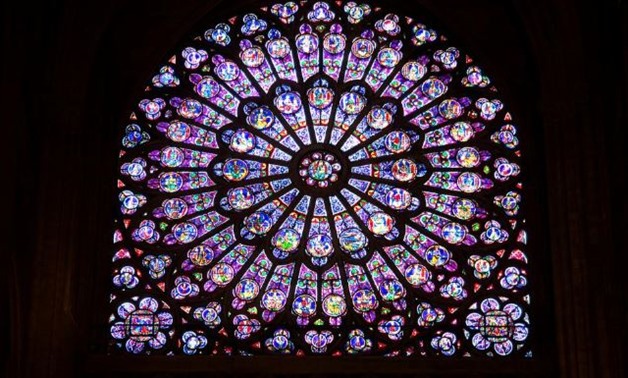
FILE PHOTO: View of the north rose window (rosace) of Notre-Dame de Paris Cathedral in Paris October 18, 2012. REUTERS/Charles Platiau/File Photo
PARIS (Reuters) - Four-hundred-year-old paintings hung high inside Notre-Dame were damaged by the immense fire that engulfed the Paris cathedral, but emergency workers formed a human chain to whisk gem-studded chalices and other priceless artefacts out of harm’s way.
Notre-Dame’s famed stained-glass rose windows and most of its many religious relics appeared to have escaped the worst of Monday’s inferno as well, easing fears for the fate of the vast trove of artworks in the 800-year-old gothic cathedral.
Among the most cherished articles to make it out unscathed was the “Sainte Couronne” (holy crown), made of braided reed brought to France from Constantinople in the 12th century. Though lacking its original thorns, the crown has been revered as an object of Christian worship for centuries.
Gold, silver and gem-inlaid chalices, candelabras and many other artefacts survived the blaze thanks to quick-thinking firefighters, police and city employees who formed a human chain to move revered artefacts away from the flames.
Paris Mayor Anne Hidalgo tweeted a picture of heavy-set candlesticks stacked in the safety of nearby Paris City Hall.
Art specialists were still poring over the extent of the damage to Notre-Dame’s 13th-century South Rose Window, measuring 10 meters across (33 feet), and other stained-glass masterpieces still standing after the cathedral’s wood-beamed roof collapsed.
“It seems they have not been destroyed for now, although we’ll have to see what real state they’re in, and whether they can be restored properly,” said Maxime Cumunel, secretary general of France’s Observatory for Religious Heritage.
“We have avoided a complete disaster. But some five to 10 percent of the artwork has probably been destroyed, we have to face up to that,” Cumunel said. Four of the largest-scale 17th and 18th century paintings depicting scenes from the lives of the apostles had been damaged, at least in part, he added.
Culture Minister Franck Riester said the paintings were mainly affected by smoke damage, rather than by flames.
The artworks, which were dampened during the 15-hour battle to douse the blaze, will be removed from Friday and transferred to the Louvre museum, where other objects will also be kept, for attempts at restoration, he added.
DAMAGE “MAKES ME QUAKE”
It remained unclear how well the cathedral’s towering master organ, embedded into a sculpted wooden casing, had fared, as rescuers remained on high alert for the possibility that some of Notre-Dame’s fragile vaults might come crashing down.
The organ - which survived the French Revolution in the late 18th century, when it was used for recitals of patriotic songs - may have been slightly damaged too, according to Cumunel, though city hall officials said it was largely intact.
“What’s happened is really disturbing and makes me quake,” said Veronique Proust, a specialist guide who has led tours of the cathedral and its treasury for a quarter century.
“For 25 years I’ve shown these treasures, the exceptional quality of the stone carvings, now I’ve got nothing to show anymore.”
Most of the sacramental artefacts in Notre-Dame’s treasury - where they were traditionally kept as reserves to be sold off or melted down in times of need - date from the 19th and 20th centuries.
It was not immediately clear how much Notre-Dame’s treasures were worth, with Riester only pointing to the many “years and hundreds of millions” of euros of investment that would be required to restore the cathedral.
A combined 460 million euros ($520 million) has already been pledged for reconstruction and restoration efforts, led by a 100 million euro donation from Francois-Henri Pinault, billionaire boss of Gucci-owner Kering, and 200 million euros from his rival Bernard Arnault, head of luxury group LVMH.
Oil company Total promised 100 million and Paris City Hall a further 50 million.
State-owned investment fund Caisse des Depots said it would donate oak timber from the forests it owns to help rebuild the framework under the cathedral roof, which went up in flames.
Other relics that made it out of the wreckage included a tunic worn by Saint Louis, a 13th-century king of France, while the cathedral’s 13-tonne bell, its largest, which rings sonorously on special occasions like Easter, was spared.
Sixteen bronze statues that adorned Notre-Dame’s collapsed spire - itself a 19th-century restoration - were airlifted out just days before the fire as part of ongoing renovations.
A gold cross stood eerily intact above the altar on Tuesday, surrounded by debris - the first images from inside the cathedral that reached the wider world.
Additional reporting by Julie Carriat; Editing by Luke Baker and Mark Heinrich


Comments
Leave a Comment